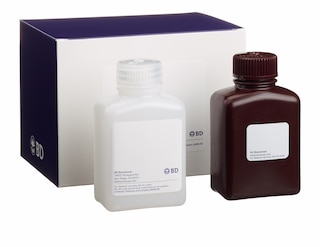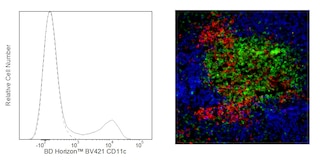Old Browser
This page has been recently translated and is available in French now.
Looks like you're visiting us from {countryName}.
Would you like to stay on the current country site or be switched to your country?


.png)

Multicolor flow cytometric analysis of CD283 (TLR3) expression by mouse splenocytes. C57BL/6 mouse splenic leucocytes were surface stained with FITC Hamster Anti-Mouse CD3e (Cat. No. 553062/553061/561827), Alexa Fluor® 700 Mouse Anti-Mouse NK1.1 (Cat. No. 560515), BD Horizon™ BV510 Rat Anti-Mouse Ly-6G and Ly-6C (Cat. No. 563040), and BD Horizon™ BV421 Hamster Anti-Mouse CD11c (Cat. No. 562782) antibodies. The cells were washed, fixed, and permeabilized using the BD Cytofix/Cytoperm™ Fixation/Permeabilization Solution Kit (Cat. No. 554714). The cells were then stained with either PE Mouse IgG1, κ Isotype Control (Cat. No. 554680; Left Plot) or PE Mouse Anti-Mouse CD283 (TLR3) antibody (Cat. No. 565984; Right Plot). Two-color contour plots showing the correlated expression CD11c versus CD283 (TLR3) [or Ig Isotype control staining] were derived from Ly-6G and Ly-6C- NK1.1- CD3e- gated events with the forward and side light-scatter characteristics of intact splenic leucocytes. Flow cytometric analysis was performed using a BD LSRFortessa™ Cell Analyzer System.
.png)

BD Pharmingen™ PE Mouse Anti-Mouse CD283 (TLR3)
.png)
Regulatory Status Legend
Any use of products other than the permitted use without the express written authorization of Becton, Dickinson and Company is strictly prohibited.
Preparation And Storage
Recommended Assay Procedures
For optimal and reproducible results, BD Horizon Brilliant Stain Buffer should be used anytime two or more BD Horizon Brilliant dyes are used in the same experiment. Fluorescent dye interactions may cause staining artifacts which may affect data interpretation. The BD Horizon Brilliant Stain Buffer was designed to minimize these interactions. More information can be found in the Technical Data Sheet of the BD Horizon Brilliant Stain Buffer (Cat. No. 563794).
Product Notices
- Since applications vary, each investigator should titrate the reagent to obtain optimal results.
- Please refer to www.bdbiosciences.com/us/s/resources for technical protocols.
- Alexa Fluor® is a registered trademark of Molecular Probes, Inc., Eugene, OR.
- Caution: Sodium azide yields highly toxic hydrazoic acid under acidic conditions. Dilute azide compounds in running water before discarding to avoid accumulation of potentially explosive deposits in plumbing.
- For fluorochrome spectra and suitable instrument settings, please refer to our Multicolor Flow Cytometry web page at www.bdbiosciences.com/colors.
- An isotype control should be used at the same concentration as the antibody of interest.
Companion Products






The PaT3 monoclonal antibody specifically binds to the Toll-like receptor 3 (TLR3), which is also known as CD283. CD283 belongs to the mammalian toll-like family of pattern recognition receptors (TLR) which participate in innate immune responses to microbial pathogens. It is a type I transmembrane glycoprotein that has an extracellular domain with leucine-rich repeats and a cytoplasmic domain with homology to the cytoplasmic region of IL-1RI/CD121a. CD283 is differentially expressed on splenic CD8+ dendritic cells, macrophages, and marginal zone B cells. It is expressed on the cell surface as well as intracellular compartments including endolysosomes. As in the case of viral infection, CD283 senses double-stranded RNA (dsRNA) in endolysosomes which subsequently leads to the production of antimicrobial peptides and proinflammatory cytokines by responding cells. CD283 can also be triggered by the synthetic analog, polyinosinic:polycytidylic acid (Poly I:C). The PaT3 monoclonal antibody can reportedly augment TLR3-mediated cellular responses to dsRNA. The PaT3 antibody does not crossreact with human CD283 (TLR3).

Development References (3)
-
Alexopoulou L, Holt AC, Medzhitov R, Flavell RA. Recognition of double-stranded RNA and activation of NF-kappaB by Toll-like receptor 3.. Nature. 2001; 413(6857):732-8. (Biology). View Reference
-
Jelinek I, Leonard JN, Price GE, et al. TLR3-specific double-stranded RNA oligonucleotide adjuvants induce dendritic cell cross-presentation, CTL responses, and antiviral protection.. J Immunol. 2011; 186(4):2422-9. (Biology). View Reference
-
Murakami Y, Fukui R, Motoi Y, et al. Roles of the cleaved N-terminal TLR3 fragment and cell surface TLR3 in double-stranded RNA sensing.. J Immunol. 2014; 193(10):5208-17. (Immunogen: Blocking, Flow cytometry, Functional assay, Immunoprecipitation). View Reference
Please refer to Support Documents for Quality Certificates
Global - Refer to manufacturer's instructions for use and related User Manuals and Technical data sheets before using this products as described
Comparisons, where applicable, are made against older BD Technology, manual methods or are general performance claims. Comparisons are not made against non-BD technologies, unless otherwise noted.
For Research Use Only. Not for use in diagnostic or therapeutic procedures.
Report a Site Issue
This form is intended to help us improve our website experience. For other support, please visit our Contact Us page.